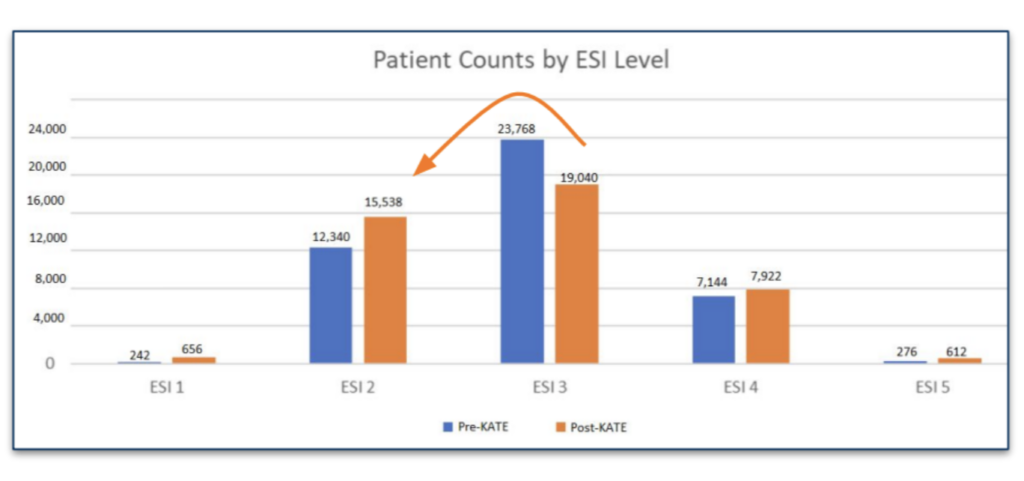Healthcare is continually evolving as it seeks to improve care delivery and patient outcomes. In the past decade, new technology has been rapidly incorporated into medical practice. This includes using informatics in nursing and more recently artificial intelligence (AI) in healthcare settings to enhance workflows, clinical insights, and nurse empowerment.
Not long ago, many healthcare systems still relied on paper charting to document patient care. Today, as many as 96% of non-federal acute care hospitals use an electronic health record (EHR). However, the data contained in EHRs is only useful when it is easily accessible and relevant.
As EHRs have become increasingly complex, studies have emerged assessing the time spent on electronic records rather than patient care; in one systematic review, as much as 22% of a nurse’s workday was spent interacting with an EHR. That’s nearly three hours out of a twelve-hour shift.
In the face of this, AI applications are quickly becoming a crucial aid to solving the challenges of delivering care effectively based on timely, accurate insights. In the emergency department (ED), this is especially important, with the increasing acuity level of patients and newer-to-practice nursing resources joining the ranks of emergency department staff.
KATE AI is a revolutionary ED triage software designed specifically for nurses on the front lines of emergency care. It provides real-time AI-powered clinical guidance and nursing education to support ED Triage accuracy and early sepsis detection, improving clinical outcomes, health equity, nursing staff retention, and operational and financial outcomes. Importantly, it does this in synergy with ED nurses, allowing them to operate to their highest clinical level while returning time to direct patient care.

The Essence of Human Touch in Emergency Care
While we have witnessed various technological advances in emergency medicine in the past several years, nothing will ever replace the importance of human touch in direct patient care. Nurses are uniquely at the heart of important mission and are often the first face a patient sees in crisis.
When patients and their families experience a medical emergency, they do not look directly to technology for reassurance. They look to the empathy, intuition, and interaction between them and the clinician providing care.
Whether it’s someone frightened following a serious accident or injury, a family worrying about a grandmother’s fall, or a parent distraught over their child’s sudden illness, it is the comfort of human touch and confident nursing care that helps them along the road to recovery.
Nurse interaction with patients starts with each patient being Triaged using the Emergency Severity Index (ESI). This critical initial clinical assessment, defined as the standard of care by the Emergency Nursing Association (ENA), sets the priority and trajectory of care for the patient. With increasing patient ED volumes and associated wait times, getting this decision right, is critical to the patient experience, improving ED throughput, and clinical care and outcomes.
In this high-stress environment, it’s crucial that hospital leaders and nursing management develop initiatives that encourage the use of informatics in nursing and specifically leverage the benefits of AI in healthcare to support clinical decision-making and the delivery of this essential human nursing care.
The Synergistic Relationship Between AI and Human Care Providers
AI technology often faces critiques that it may be used in place of these human contributions, but it is easy to see how a nurse’s role is indispensable. By using AI tools in nursing to support the critical decision-making process nurses must use daily in the chaos of emergency care, we give them a tool that helps ensure they can be at their best.
“We need to do a better job of empowering nurses with technology that makes a difference for both the nurse and the patient.,” says Deena Brecher, MSN, RN, FAEN, Chief Nursing Officer for Mednition, which developed KATE AI. “KATE AI reduces the administrative burden on ED nurses while providing clinical support, enabling nurses to be the best they can be.”
This helps nurses operate more efficiently during the triage process, giving them more time to focus on the human side of the nursing profession. Supported by evidence-based outcomes, KATE’s machine learning processes vast amounts of validated clinical data rapidly, returning insights within seconds that a clinician can then use to make more confident assessment decisions to improve patient outcomes for at-risk individuals.
In high-pressure, complex situations, nurses can use their clinical judgment and contextual understanding in conjunction with KATE’s clinical decision support to elevate their critical thinking skills, not subtract from them. “KATE AI should be seen as a tool to empower nurses, not replace them,” adds Brecher. With KATE operating as an intelligent assistant at their side, nurses receive real-time guidance and reminders about best practices and high-risk conditions, assuring that details are not accidentally overlooked in the busy ED environment.
Naturally, some hesitation may exist when ED leadership or nurses first encounter KATE. A part of successfully implementing data-driven healthcare solutions is understanding how the AI system’s design incorporates feedback mechanisms to ensure it remains adaptive and responsive to the realities of clinical practice and decision support systems.
This creates a nurse-first approach to AI, giving nurses an active role in refining and improving KATE’s learning and validity. By refining its inputs and recommendations based on real-world data and feedback from healthcare professionals and operating transparently, KATE AI builds trust among nursing staff. Nurses can accept, reject, or modify KATE’s recommendations based on their assessment and clinical skills.
In contrast, with an AI-first approach, the potential exists for a decision to be made primarily by the system, which lacks the nuanced insight of a highly trained and experienced triage nurse who is using all their senses to come to a decision about acuity level and the patient’s health.
Why Nurses Are Irreplaceable
These highly trained and experienced nurses are the core of any ED. Growing nursing shortages have a significant, proven negative impact on patient outcomes. At the same time, emergency department volumes and boarding times are increasing. EDs cannot afford to lose more nurses and with them, the benefits of comprehensive nursing care.
Although AI cannot mimic nursing care, KATE AI’s synergy with ED nursing staff helps mitigate the strain caused by nursing shortages, effectively eliminating many of the challenges and administrative overload that lead to burnout and problems with staff retention. Along with enhancing the clinical decision-making skills of a trained ED triage nurse, the use of AI can even help them refine their nursing practice and skills.

How KATE AI Enhances Nurse Efficiency and Effectiveness
A technology born from listening to nurses’ needs, KATE AI is EHR-integrated and recognizes over 100 high-risk conditions, including stroke, sepsis, and chest pain, with high accuracy, leveraging AI algorithms to process data such as vital signs and nursing assessments and free text notes to return recommendations on Emergency Severity Index (ESI) triage levels. Ultimately, this streamlines nurses’ ability to rapidly categorize (ESI) triage levels and improve ED throughput.
In one study, this led to 3,198 patients receiving a higher triage designation — ultimately representing higher reimbursement rates for the healthcare providers involved. In another data analysis, KATE AI demonstrated a strong ability to close health equity gaps by identifying 96.8% of all patients with signs of stroke; previously, 33.17% were under-triaged due to gender bias.
When KATE AI is used to evaluate patient data, emergency departments can realize improved patient outcomes, reduced wait times, opportunities for better patient education and communication, decreased error rates and enhanced patient safety due to faster intervention response times and more accurate identification of acuity level.
Embracing the Future of Nursing and Technology with KATE AI
In Florence Nightingale’s words, “Nursing is a progressive art such that to stand still is to go backward.” Enhancing the human element of emergency care with KATE AI represents this progression, supporting higher-quality care while complementing the invaluable skills of an organization’s nursing team.
If you’re ready to learn more about KATE AI’s capabilities, the use of artificial intelligence in healthcare, and hear real testimonials from other leaders seeing the benefits of AI in healthcare, contact Mednition today.
We’ll provide you with the resources you need to start a conversation with your organization about the impact of AI in delivering data-driven, innovative healthcare.
